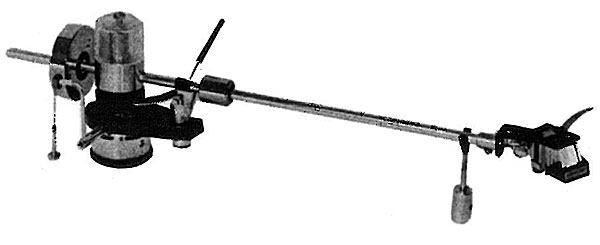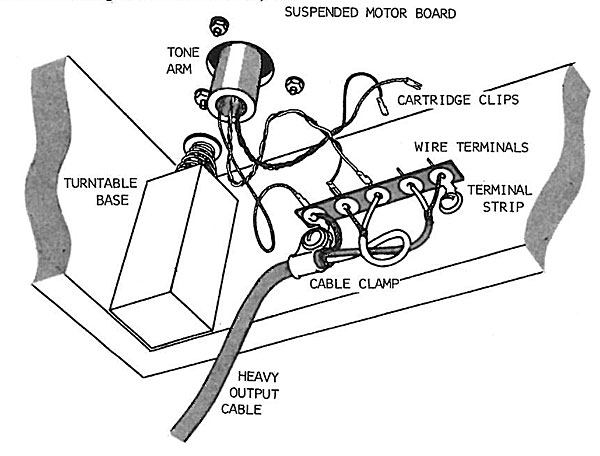| Columns Retired Columns & Blogs |
In magic audiophile land, we'd be able to get an update note on that as compared to the current crop of tonearms!
:D

The arm resembles the now-discontinued Decca International in two respects: one good, the other not so good. Both are fully viscous-damped unipivot designs (a single needle bearing for vertical and lateral motions), which is good. But both require more depth under the motor board for attachment of their cable plug (into the arm base) than is available from many modern turntables, which is not so good.
Space Matters
This business of the space-wasting bottom plug is in fact reaching a point of absurdity. We, and a lot of consumers, made such a fuss about the problem in the Decca International arm that we hardly expected to see, two years later, several new arm manufacturers, including Infinity, making exactly the same dumb goof-up. It appears, in fact, that every designer of a recent new pivoted tonearm must have looked at the Decca and said "Gee, that's a nice tonearm, now we gotta make us our own one wid da cable plug stickin' out too far underneath." So, you use a deeper turntable base, or you prop the thing up on a sub-base, which latter expedient is how we got around the problem.

While we're at it, there's another minor bit of dumbdumb running rampant in tone arm design today, and that is the use of expensive-looking output cables that are so infernally heavy and stiff that they kill the effectiveness of a good turntable's anti-shock suspension. We don't care how tacky it looks, the only proper way to install an arm is with light cables coming from beneath the tone arm base to a terminal strip, which can then be fastened to the un-suspended part of the base and used to anchor the heavy wires running to the preamp. The diagram (fig.1) illustrates how this can be done practically, in case any designer of future arms cares to do this part of the design right.
Performance
Now that we've vented our editorial spleen about that, back to the Formula 4, which is as bad as any in that one particular respect but superb in just about every other.
As we indicated in the last issue, the arm obtains its tracking force via a small tubular weight that slides along the arm, between the base and the cartridge. The arm is first balanced-out to zero force with the cartridge installed, with the tubular weight all the way back and the counterweight at the rear being used to balance the arm. Then the tubular weight is slid forward along a series of calibration marks (aach of which represents 1/10 of a gram). Since the tubular weight travels away from the arm base when increasing the tracking force, it automatically raises the effective mass of the arm—a factor that should in most cases be increased when cartridges of reduced compliance have to be operated at higher-than-usual forces.
It is not however necessary to accept this increase of mass if for any reason it is found undesirable. The arm can be operated at minimal mass with any cartridge by keeping the tubular weight all the way to the rear and using the rear counterweight to effect the tracking-force adjustment. The minimum effective mass when so used is around 3.75 grams. When used according to the instructions, and counterbalancing an ADC XLM-II, the effective mass (minus that of the cartridge) is around 4.5 grams, rising to about 6 grams—an ideal figure-when tracking a Decca Export at 3.5 grams force.
The only other criticism we found—and it is a minor one—was that the arm-lift "shelf" wasn't quite long enough. Turned so that it would hold the arm aloft when swung out to the rest post, it wouldn't lift the arm when it was in a run-in groove. Adjusted so that it would lift the arm when the latter was in the run-in, it dropped it almost to the motor board when the arm was swung to within an inch of the rest post. We opted for the ability to lift the arm from a run-in groove, and averred that the outer dropoff was a minor irk as long as the arm height is set so that the stylus doesn't hit the motor board when it runs off the end of the lift shelf.
The arm is beautifully made and a pleasure to handle. And sonically? As smooth a high end as we have heard from the cartridges we tried (a Decca, an XLM-II and a Shure V-15-IIIG), very deep, tight low end and, as an added bonus (shared by other fully-damped arms), a reduced tendency toward acoustic feedback when used with turntables that tend that way. And all for under $150! Indubitably a winner!
One final observation
Since a unipivot arm is "balanced" on only two tiny points—the tip of the vertical pivot needle and the stylus tip—and the barrel of the arm is above both of these points, its natural tendency is to fall over on its side, just as would a camera tripod minus one leg. For this reason, the Formula 4 is like other unipivot designs in that its counterweight is eccentric, so that most of its mass "hangs down" below the tip of the unipivot. Thus it is the counterweight that holds the cartridge parallel to the disc surface (as viewed from in front), and one of the hairier setup adjustments of the arm involves rotating the counterweight about the arm tube until the cartridge. resting on a disc, is parallel to it.
Also of great importance here is the requirement that the antiskate thread's anchor and groove (on the plastic drum atop the pivot) be at exactly the same height as the bottom of the pivot pin. If it isn't so adjusted, the tension of the antiskate thread can cause the cartridge to assume varying degrees of tilt at different spots across the disc. This simple adjustment is described in the booklet that comes with the Formula 4, and although most samples of the arm come with this properly set (both of ours did), we have heard of some that didn't.

In magic audiophile land, we'd be able to get an update note on that as compared to the current crop of tonearms!
:D